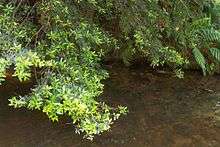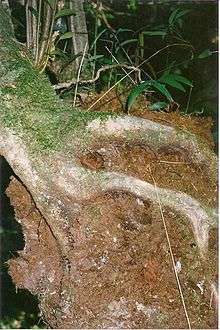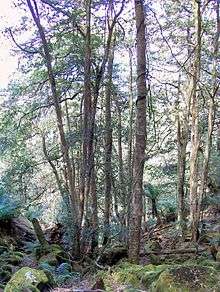Elaeocarpus holopetalus
| Black olive berry | |
|---|---|
 | |
| E. holopetalus, Blue Mountains National Park, Australia | |
| Scientific classification | |
| Kingdom: | Plantae |
| (unranked): | Angiosperms |
| (unranked): | Eudicots |
| (unranked): | Rosids |
| Order: | Oxalidales |
| Family: | Elaeocarpaceae |
| Genus: | Elaeocarpus |
| Species: | E. holopetalus |
| Binomial name | |
| Elaeocarpus holopetalus F. Muell. | |
Elaeocarpus holopetalus, mountain quandong , is a small rainforest tree of eastern Australia. It grows from near the Snowy River (37°S) to Chaelundi National Park (29°S) in northern New South Wales. It grows at high altitude in gullies.
E. holopetalus is often seen with the southern sassafras, such as at Errinundra National Park, South East Forest National Park, Blue Mountains National Park, and Barrington Tops National Park. It is also associated with the Antarctic beech at Barrington Tops National Park and other northerly sites such as New England National Park.
Common names include black olive berry, mountain blue-berry, and mountain quandong.
Description
It is usually a large bush or a small tree. However, rare specimens are most impressive; being 2 m wide at the base, and 25 m tall. The trunk is straight with dark grey or brown outer bark, relatively smooth with some fissures and wrinkles.
Leaves are particularly serrated, 3 to 7 cm long, mid to dark green above, and paler below. They show prominent venation, particularly on the underside. Another identifying feature of this and other Elaeocarpus trees is the senescent red leaves.
White flowers appear on paired racemes in November and December. The fruit is a black- or (immature) maroon-coloured drupe, 9 mm long, maturing from March to October. Like many Australian Elaeocarpus trees, germination is slow and difficult. However, cuttings prove more successful.
Gallery
-
E. holopetalus, Blue Mountains National Park
-
E. holopetalus - leaves and fruit
-

A mountain stream with orange/red senescent leaves of E. holopetalus, other leaves are southern sassafras and Blue Mountains ash.
-

Black olive berry growing as a hemiepiphyte on a soft tree fern at Devil's Creek, South East Forest National Park
-

E. holopetalus (left) and southern sassafras (right) near Nimmitabel
-

Black olive berry at its best development: 25 m tall at Mount Imlay, Australia
References
- Floyd, A.G., Rainforest Trees of Mainland South-eastern Australia, Inkata Press 1989, ISBN 0-909605-57-2